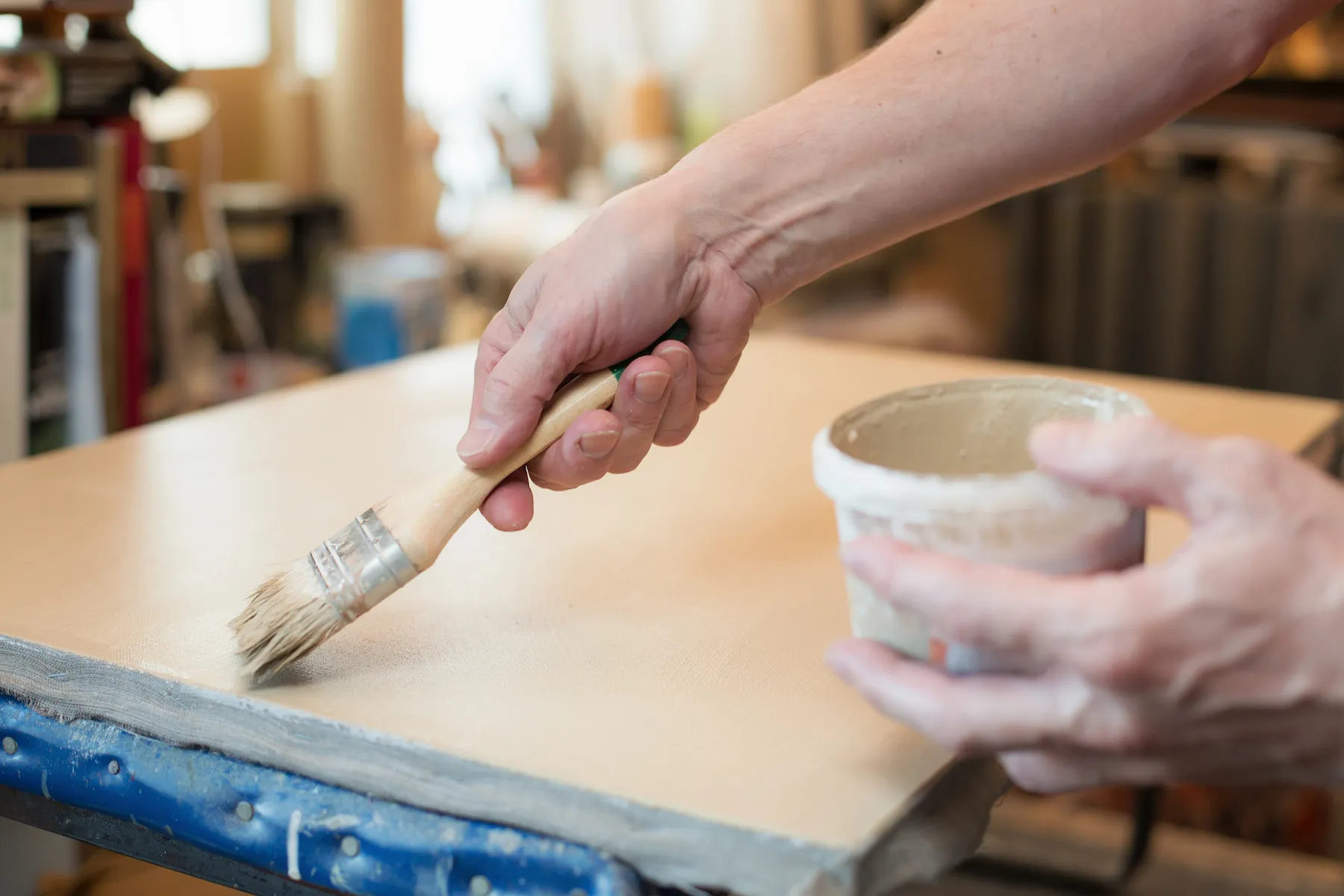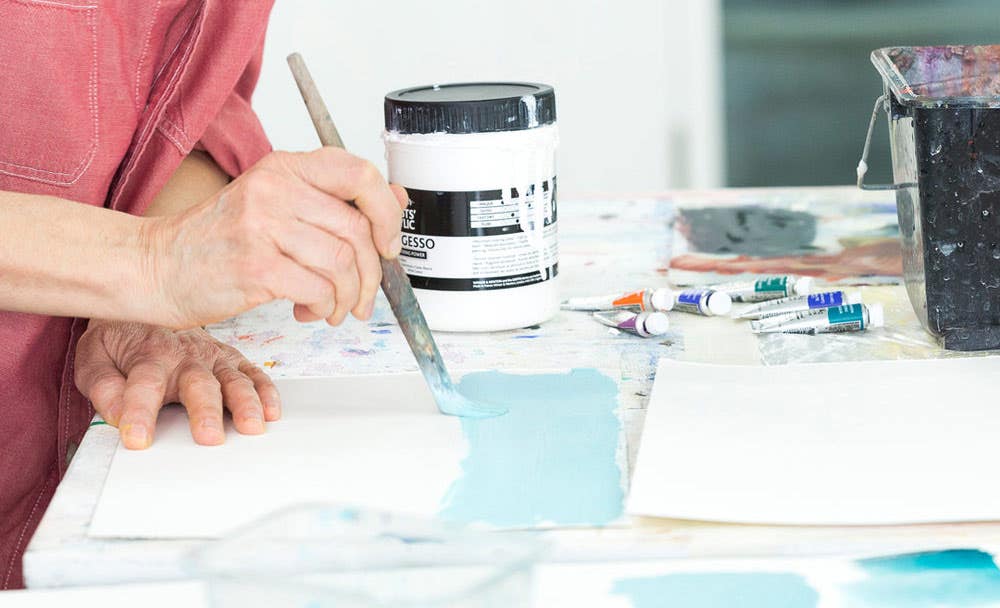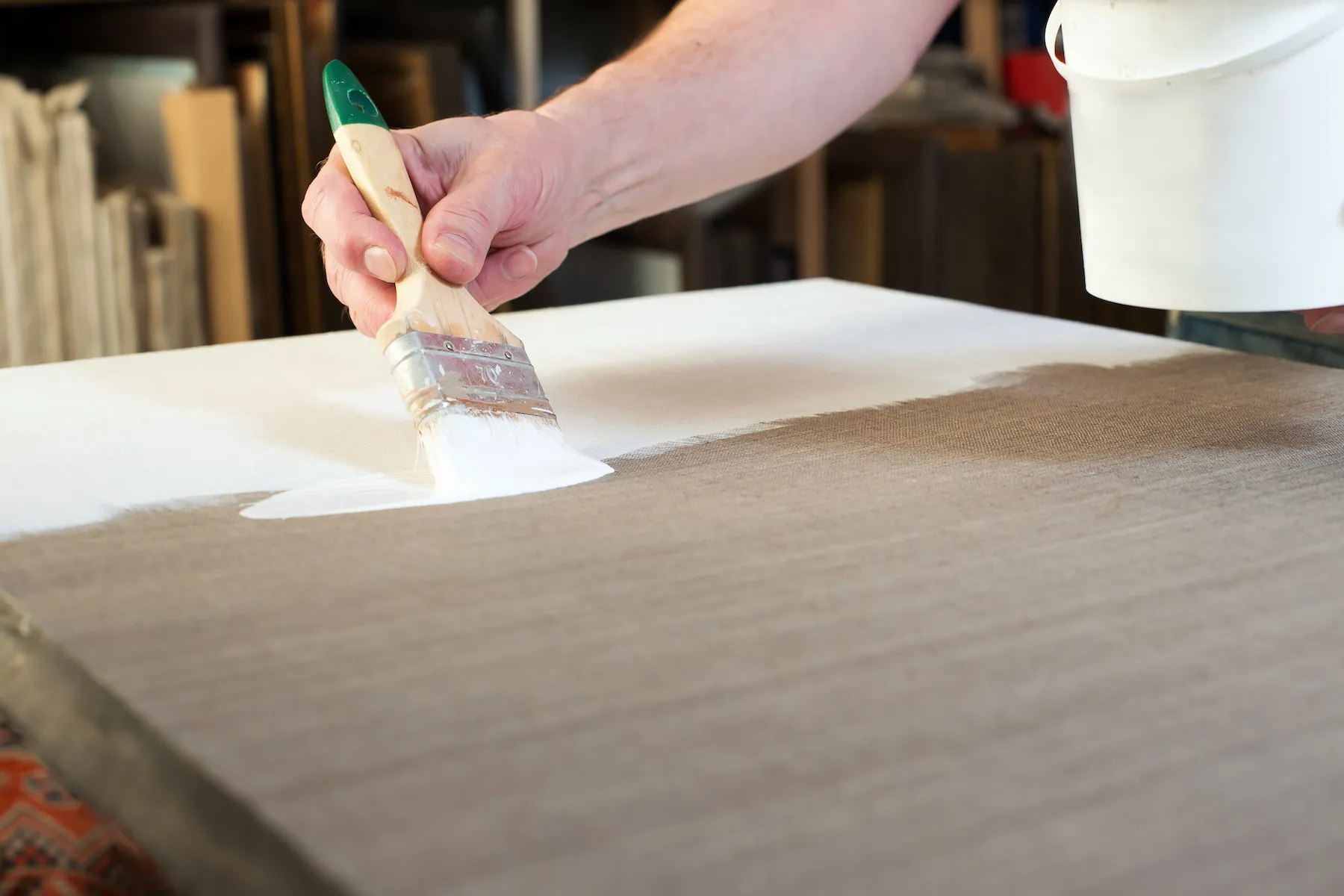Overview:
- Why use Gesso?
- What is gesso?
- What is the difference between Gesso and a Primer?
- How do I apply gesso?
- Is gesso water soluble and can I mix it with water?
- Which gesso is the right one for me?
Why use Gesso?
The abundance of materials we use to prepare our painting surfaces can seem confusing, terms like priming and undercoating is bewildering if you are new to painting. Yet preparing your painting surface is an important part of the process and will aid the overall absorption, application, health, and longevity of your painting.
It can be tempting for new artists to paint straight onto whatever surface they have, which is especially the case when some canvas can be bought “pre-primed”. The problem with doing this is that the canvas itself is not a smooth surface, it has small bumps from the weave showing through, and ‘pre-primed’ surfaces are often only primed very thinly and cheaply. Adding further layers of Gesso will create a smoother and more even painting surface, improving the quality of your paintings and your painting ability. Painting with oils on an unprimed surface will result in the oil from the paint absorbing into the canvas weave, leaving a yellow stain around the paint. This stain is the oil binder separating from the pigment, leaving the remaining paint film brittle and unadhered. It’s not dissimilar if you are painting with acrylic, yet with acrylic on an unprimed surface you will find the surface repels water and the acrylic will feel impossible to move around on the canvas.

What is gesso?
Gesso is a combination of an acrylic binder, pigment, and calcium carbonate. The pigment in most gesso will be Titanium White; however, it is possible to find coloured gesso. We’ll discuss this later in the blog. The calcium carbonate component in gesso gives it a high tooth which helps paint grip to the surface of the canvas. You can use a regular white acrylic to paint the surface, but most artists would find this surface too slippery compared to gesso and your paint may not adhere as easily
What is the difference between Gesso and a Primer?
A Gesso is a type of primer, however not all primers are Gesso. There are many different types of primers you can use on a canvas depending on your painting objective, such as an oil primer, an acrylic binder like Atelier’s Binder Medium, Golden’s Gac 100, or even a Watercolour or Pastel Ground. A Primer is anything you use to prepare a surface for painting, but most artists will use Gesso. It is a great universal primer suited to a wide variety of applications.
How do I apply gesso?
Gesso will usually come in a tub, whether small or large and sometimes it will be in a tube, however this is a lot less common. You’ll want to use a large brush like the Mont Marte Gesso Brush or a Princeton Redline brush as you’ll be covering a lot of area when priming your canvas or panel. If you’re using it from a tub, you’re welcome to dip your brush into the tub and apply directly onto the surface. You’ll want to use a back and forth or up and down motion when applying the gesso to minimise the amount of brush strokes visible on the surface.
Gesso is meant to be applied in layers (artists of old would go as far to gesso their surface up to 10 times before painting) but for most artists, one to three layers is more than enough. Many artists will also sand back their surface after applying a layer of gesso to completely remove all brush strokes and create an even surface. This sort of thing is important to artists who do not wish to have any brush strokes visible and a very smooth, flat finish on their works. Of course, if this doesn’t sound appealing, you do not have to sand the gesso back. Be aware though that without sanding, some brush strokes will still be visible in the final piece, so make sure that you follow the back-and-forth application method to minimize this texture.
Is gesso water-soluble and can I mix it with water?
All acrylic Gesso will be water based and can be mixed with water to achieve the consistency that you like. Be mindful of using too much water, as this will negate many benefits of using Gesso in the first place. Gesso is supposed to be built up in layers, so the more water that you use, the more layers may be needed to achieve the desired smoothness or adhesion.
Which gesso is the right one for me?
Acrylic Gesso
Acrylic Gesso is the stock standard Gesso that you will most probably find in all art supply stores. It is a permanent and flexible water-based ground that dries quickly to a bright white, matte finish. It is thick but fluid and can be applied in either thick or thin coats depending on the artists preference. Suitable for any non-oily surface such as plywood, canvas, cardboard or plaster. The Matisse Gesso, Atelier Gesso, Mont Marte Gesso and the Michael Harding Non-Absorbent white primer are all great Acrylic Gessos.
Coloured Gesso
Coloured Gesso is a convenience product made for artists who don’t wish their paintings to be undercoated in white. By using a coloured Gesso you can remove the need to apply additional acrylic or oil undercoats on top of a bright white Gesso. Black Gesso is the most common coloured Gesso and it is great for artists seeking a dark base. Indigenous artists for example typically like to start from a black base and build lighter colours on top of it. If that sounds like something you might like to do, a coloured gesso could be right for you. The Matisse Background Colours, Matisse Black Gesso, Mont Marte Black Gesso and Michael Harding Non-Absorbent Primers are great coloured Gessos.
Low Viscosity Gesso
Viscosity is the measure of a fluid’s resistance to flow, so something that is highly viscous is referred to as being “thick”, for example honey is very viscous when compared to water, which is conversely not very viscous. Traditional Gesso is referred to as being quite thick but a product like Low Viscosity Gesso flows and makes the application of Gesso exceptionally easier. However, the drawback on using Low Viscosity Gesso is that you may have to do more layers to achieve your desired finish. Matisse’s Low Viscosity Gesso is a great option here.
High Tooth Gesso
High Tooth Gesso is specially formulated for encaustic painting, with a lower proportion of acrylic binder to solids, making it more absorbent and receptive surface for wax-based paint. It has a bright white matte finish with a rough textured finish. A high tooth gesso will offer extra tooth and absorbency when compared to standard Gesso, making it ideal for encaustic works, soft pastels, or oil pastels. Matisse High Tooth Gesso is a great option here.
Transparent Gesso
Transparent Gesso is still formulated with an acrylic binder and calcium carbonate, but without any pigment, so the transparent drying quality of the acrylic binder is most present feature of this gesso. However, it is important to note that while it is transparent, it will not be completely crystal clear as the calcium carbonate content that gives the gesso its tooth will make the gesso slightly cloudy. A transparent gesso does also give you the opportunity to mix in acrylic colours and make your own coloured gesso at any time. Langridge’s Clear Acrylic Primer and Matisse’s Transparent Gesso are great options for this.
Your one-stop shop for art supplies
Gesso is a crucial product that will allow you to paint confidently on whatever surface that you decide to paint on. You’ll find yourself more confident that your painting will have an even finish and be properly prepped for applying paint. You will remove grooves and bumps from the weave in raw fabrics like canvas and linen, and know that your paint will dry, adhered correctly, without colour falling out, leaking, or becoming brittle and susceptible to damage. Don’t forget to check out other art supplies or browse our full selection of paint brush sets, canvas, mediums, and art paper.













































































